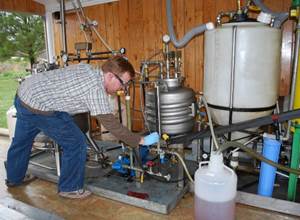Biodiesel changed the value of yellow grease (used cooking oil). Can small-scale, on-site biogas change the value of food waste in a similar way?
If food waste were seen as more valuable, then surely far less of it would be simply thrown away, no? That is, if it was obvious to more people that the nutrients in food waste should be returned to the land— making healthier crops and people, and not producing eutrophication in streams and oceans— and that food waste can be used to gain valuable energy in the form of a gas which can replace natural gas in a cost-effective manner,… then surely more people would act to gain that value, right?
So, the Big Question: Is it possible for a few people with modest resources to change the nation’s perception of the value of food waste? History says the answer is yes.
Consider: A parallel example of such a catalytic impact is illustrated by the biodiesel revolution, where a diverse group of early adopters was arguably the pivot of a process that changed the perceived value of used cooking oil.
Recall that, a bit more than two decades ago, such used cooking oil— sometimes called “yellow grease”— was a literal glut on the market, difficult to handle and extremely messy, and which required relatively expensive disposal. Today, it’ a challenge to find business willing to give away what they would, twenty years ago, have gladly and dearly paid someone to regularly take away. The amount of used cooking oil which ends up in a landfill these days must certainly be a minor fraction of the pre-biodiesel percentage.
The forces that acted to produce this change in value were broad and diverse, but they were ultimately powered by a fact of physics: as with food waste, used cooking oil has great deal of energy locked in its carbon bonds.
Many years ago, Dr. Tom Reed was aware of this, and familiar with European efforts to produce biodiesel from agricultural oils. Pursuing that interest, he got permission to take a gallon of yellow grease from a dumpster behind his local McDonald’s, and he converted it to biodiesel. (A small beginning, no? One gallon…) Subsequently he produced and gave 100 gallons of biodiesel to Denver’s RTD bus service for testing. Finally he made a public release of a clear description of how to make biodiesel from waste vegetable oil. This simple recipe was (according to some) the key which fueled the early development of biodiesel processor equipment by many others, and the largely cooperative improvement of that equipment through communications among those interested. Indeed, the recipe itself has been improved through evolution.
Many of the early enthusiasts could be fondly and accurately described as “dedicated crazies”, given that it is not clear that they had any economic basis for their pursuit of small-scale biodiesel. They made progress because they wanted to, without concern for the bottom line. For them, the driver was passion. (You can get some idea of what these people were like by looking at “The Fat of the Land”, an amateur video by several women who drove across the country on biodiesel, at a time when few knew what that was...)
Along the way, as things evolved, some few of those in this group made the transition from hobby to industry, and then built a foundation of business underneath their passion.


So to again answer the question we started with, history seems to indicate that, in fact, a small group of people can impact the perceptions of an entire nation. In sum, physics is on our side, and it’s hard to find a stronger ally than physics.
